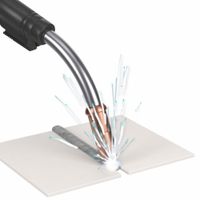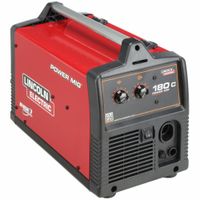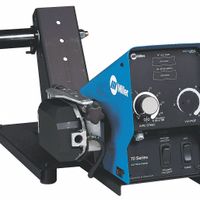Call +(254) 703 030 000 / 751 483 999 / 721 704 777
- Home
- Welding
- Arc Welding
- Mig Welding
.....Read More
Frequently Asked Questions
What is MIG welding?
MIG welding, or Metal Inert Gas welding, is a type of arc welding process that uses a continuous solid wire electrode heated and fed into the weld pool from a welding gun. The process is shielded by an external gas, typically argon or a mixture of argon and carbon dioxide, which protects the weld from atmospheric contamination. This method is also known as Gas Metal Arc Welding (GMAW).
MIG welding is popular due to its versatility, speed, and ease of use. It is suitable for welding a wide range of metals, including carbon steel, stainless steel, and aluminum, making it ideal for both industrial and hobbyist applications. The process is semi-automatic or automatic, which allows for high productivity and consistent weld quality.
The equipment used in MIG welding includes a welding gun, a power supply, a wire feed unit, and a shielding gas supply. The welding gun is equipped with a trigger that controls the feeding of the wire and the flow of the shielding gas. The power supply provides a constant voltage, which is necessary for maintaining a stable arc.
MIG welding is characterized by its ability to produce long, continuous welds quickly, which is beneficial in manufacturing and construction industries. It is also known for producing clean welds with minimal spatter, reducing the need for post-weld cleaning.
However, MIG welding requires a clean surface to ensure a strong weld, and the equipment can be more expensive compared to other welding methods. Additionally, the process is less effective outdoors or in windy conditions due to the potential for shielding gas dispersion.
Overall, MIG welding is a widely used and efficient welding process that offers high-quality results for a variety of applications.
How does MIG welding differ from TIG welding?
MIG (Metal Inert Gas) welding and TIG (Tungsten Inert Gas) welding are both arc welding processes that use an inert gas to protect the weld area from contamination. However, they differ in several key aspects:
1. **Electrode and Filler Material**:
- **MIG Welding**: Uses a consumable wire electrode that is continuously fed through the welding gun. The wire acts as both the electrode and the filler material, which melts to form the weld.
- **TIG Welding**: Uses a non-consumable tungsten electrode to produce the weld. A separate filler rod may be used if additional material is needed, but it is not always necessary.
2. **Shielding Gas**:
- **MIG Welding**: Typically uses a mixture of argon and carbon dioxide or pure argon as the shielding gas to protect the weld from atmospheric contamination.
- **TIG Welding**: Primarily uses pure argon or helium as the shielding gas, providing a cleaner weld with less spatter.
3. **Welding Technique**:
- **MIG Welding**: Generally easier to learn and faster, making it suitable for high-production environments. It is often used for welding thicker materials and is more forgiving of minor surface contaminants.
- **TIG Welding**: Requires more skill and precision, as the welder must manually feed the filler rod while controlling the torch. It is ideal for thin materials and applications requiring high-quality, precise welds.
4. **Applications**:
- **MIG Welding**: Commonly used in automotive, construction, and manufacturing industries for welding steel, stainless steel, and aluminum.
- **TIG Welding**: Preferred in aerospace, art, and industries requiring high-quality welds, such as for stainless steel, aluminum, and exotic metals.
5. **Weld Quality**:
- **MIG Welding**: Produces strong welds but may have more spatter and less aesthetic appeal.
- **TIG Welding**: Produces cleaner, more precise welds with a superior finish and minimal spatter.
What materials can be welded using MIG welding?
MIG welding, or Gas Metal Arc Welding (GMAW), is a versatile welding process suitable for a variety of materials. The primary materials that can be welded using MIG welding include:
1. **Carbon Steel**: This is the most common material welded with MIG due to its ease of welding and wide availability. MIG welding provides strong, clean welds on carbon steel, making it ideal for construction, automotive, and general fabrication.
2. **Stainless Steel**: MIG welding is effective for stainless steel, offering good control over heat input, which is crucial to prevent warping and maintain corrosion resistance. It is widely used in the food, medical, and chemical industries.
3. **Aluminum**: MIG welding is suitable for aluminum, especially when using a spool gun to feed the softer aluminum wire. It is commonly used in the automotive and aerospace industries due to aluminum's lightweight and corrosion-resistant properties.
4. **Copper and Copper Alloys**: MIG welding can be used for copper and its alloys, such as bronze and brass, though it requires careful control of heat to prevent distortion and maintain electrical conductivity.
5. **Nickel and Nickel Alloys**: These materials can be welded using MIG, often in applications requiring high corrosion resistance and strength at elevated temperatures, such as in chemical processing and power generation.
6. **Magnesium**: Although less common, MIG welding can be used for magnesium and its alloys, typically in the aerospace and automotive industries, where weight reduction is critical.
7. **Other Alloys**: Various other alloys can be welded using MIG, provided the correct filler material and shielding gas are selected to match the base material properties.
MIG welding is favored for its speed, ease of use, and ability to produce clean welds with minimal post-weld cleanup, making it suitable for both industrial and hobbyist applications.
What are the advantages of MIG welding?
MIG welding, or Metal Inert Gas welding, offers several advantages:
1. **Ease of Use**: MIG welding is user-friendly, making it ideal for beginners. The process involves a continuous wire feed, which simplifies the welding process and reduces the need for frequent stops and starts.
2. **Speed**: The continuous wire feed allows for faster welding compared to other methods like TIG or stick welding. This efficiency makes it suitable for high-production environments.
3. **Versatility**: MIG welding can be used on a variety of metals, including carbon steel, stainless steel, and aluminum. It is also effective for welding different thicknesses, from thin sheets to thick plates.
4. **Cleaner Welds**: The use of an inert gas shield reduces the amount of slag and spatter, resulting in cleaner welds that require less post-weld cleaning and finishing.
5. **Strong Welds**: MIG welding produces strong, durable welds that are suitable for structural applications. The process allows for deep penetration, which enhances the strength of the weld.
6. **Automation Potential**: MIG welding is easily automated, making it suitable for robotic welding applications in industrial settings. This increases productivity and consistency in large-scale manufacturing.
7. **All-Position Capability**: MIG welding can be performed in all positions (flat, horizontal, vertical, and overhead), providing flexibility in various welding scenarios.
8. **Reduced Welding Fumes**: Compared to stick welding, MIG welding produces fewer fumes, contributing to a safer working environment.
9. **Cost-Effective**: The efficiency and speed of MIG welding can lead to cost savings in labor and production time, especially in large-scale operations.
These advantages make MIG welding a popular choice in industries such as automotive, construction, and manufacturing.
What is the role of shielding gas in MIG welding?
In Metal Inert Gas (MIG) welding, shielding gas plays a crucial role in ensuring the quality and integrity of the weld. The primary function of shielding gas is to protect the weld pool from atmospheric contamination. During the welding process, the intense heat generated can cause the molten metal to react with elements in the air, such as oxygen, nitrogen, and hydrogen. These reactions can lead to defects like porosity, oxidation, and embrittlement, compromising the strength and appearance of the weld.
Shielding gas creates a protective barrier around the weld area, preventing these atmospheric gases from coming into contact with the molten metal. Common shielding gases used in MIG welding include argon, carbon dioxide, and mixtures of the two. Argon is an inert gas that provides excellent arc stability and produces a smooth, clean weld. It is often used for welding non-ferrous metals like aluminum and copper. Carbon dioxide, while not inert, is cost-effective and provides deep penetration, making it suitable for welding thicker materials and ferrous metals like steel.
The choice of shielding gas can also influence the welding arc characteristics, such as arc stability, spatter levels, and bead shape. For instance, a mixture of argon and carbon dioxide can offer a balance between arc stability and penetration, reducing spatter and improving weld appearance. Additionally, the flow rate and coverage of the shielding gas must be carefully controlled to ensure effective protection throughout the welding process.
In summary, shielding gas is essential in MIG welding for protecting the weld from atmospheric contamination, influencing arc characteristics, and ultimately ensuring a high-quality weld.
How do you set up a MIG welder?
1. **Safety First**: Wear appropriate safety gear, including a welding helmet, gloves, and protective clothing.
2. **Select the Right Equipment**: Choose a MIG welder suitable for your project. Ensure you have the correct wire type and size, typically ER70S-6 for steel, and the right shielding gas, usually a mix of 75% Argon and 25% CO2.
3. **Prepare the Welder**:
- Connect the power supply to the welder.
- Attach the ground clamp to a clean, unpainted metal surface on the workpiece.
- Install the welding wire spool by opening the welder’s side panel, placing the spool on the spindle, and feeding the wire through the drive rolls and into the gun liner.
4. **Set the Wire Feed and Voltage**:
- Adjust the wire feed speed and voltage settings based on the material thickness and wire size. Refer to the welder’s chart or manual for guidance.
5. **Connect the Gas Supply**:
- Attach the gas regulator to the gas cylinder and connect the gas hose to the welder.
- Open the gas cylinder valve and adjust the flow rate to about 20-25 cubic feet per hour (CFH).
6. **Check the Gun and Nozzle**:
- Ensure the contact tip and nozzle are clean and properly installed.
- Trim the wire to extend about 1/4 inch from the tip.
7. **Test the Setup**:
- Perform a test weld on a scrap piece of metal to check settings and make necessary adjustments.
8. **Begin Welding**:
- Position the gun at a 10-15 degree angle from vertical.
- Pull the trigger to start welding, maintaining a steady hand and consistent speed.
What are common issues and troubleshooting tips for MIG welding?
Common issues in MIG welding include:
1. **Porosity**: Caused by contaminants like oil, rust, or moisture. Ensure surfaces are clean and dry. Check for gas leaks and ensure proper gas flow.
2. **Spatter**: Results from incorrect voltage or wire feed speed. Adjust settings and maintain a consistent distance between the nozzle and workpiece.
3. **Inconsistent Wire Feed**: Can be due to worn drive rolls or incorrect tension. Inspect and replace drive rolls if necessary, and adjust tension.
4. **Burnback**: Occurs when the wire melts into the contact tip. Reduce wire feed speed or increase voltage. Ensure proper stick-out distance.
5. **Birdnesting**: Wire tangles in the drive rolls. Check for blockages, ensure proper liner installation, and use the correct wire tension.
6. **Lack of Fusion**: Caused by low heat input or incorrect technique. Increase voltage or wire feed speed, and ensure proper torch angle and travel speed.
7. **Excessive Penetration**: Results from too high voltage or wire feed speed. Reduce settings and maintain correct travel speed.
8. **Undercutting**: Occurs when the arc is too hot. Lower voltage or increase travel speed.
Troubleshooting tips:
- **Check Equipment**: Regularly inspect and maintain the welding machine, cables, and connections.
- **Adjust Settings**: Use the correct voltage, wire feed speed, and gas flow for the material and thickness.
- **Proper Technique**: Maintain a consistent travel speed, torch angle, and stick-out distance.
- **Use Quality Materials**: Ensure the use of clean, high-quality wire and shielding gas.
- **Environmental Control**: Weld in a draft-free area to prevent gas dispersion.
By addressing these issues and following these tips, you can improve weld quality and reduce defects in MIG welding.



